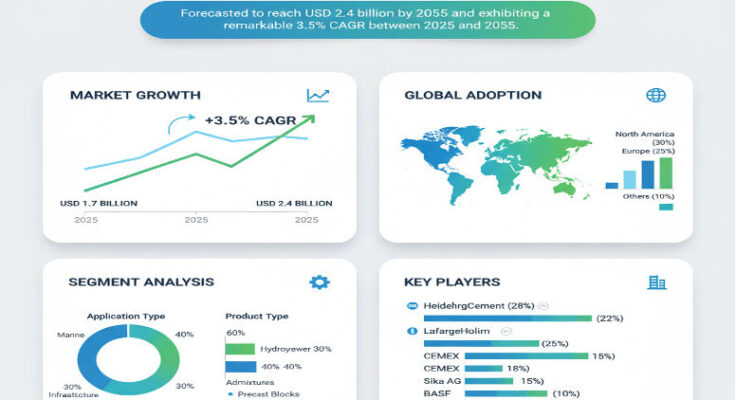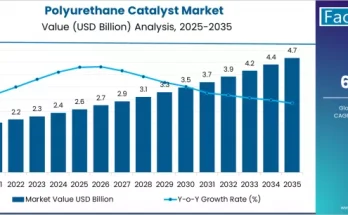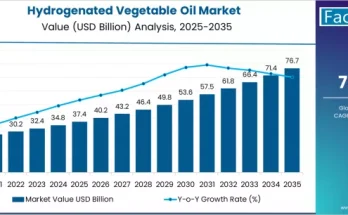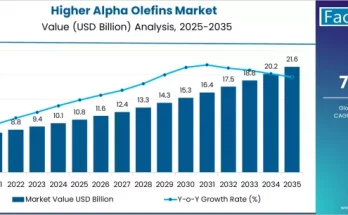The underwater concrete market is poised for significant growth as marine, hydropower, offshore energy, and underwater repair projects scale up globally. Analysts estimate the market to have reached a value of about US$ 193.11 billion in 2023, and project it to nearly double in value by the end of the next decade (around 2033), representing a robust compound annual growth rate (CAGR) of approximately 8.6% between 2023 and 2033. This strong trajectory is fueled by rising investment in ports, offshore wind farms, subsea pipelines, underwater tunnels and repair of aging submerged infrastructure.
Market Drivers and Key Growth Catalysts
Several factors are propelling the underwater concrete market forward. First, the increasing pace of marine and offshore infrastructure development—such as ports & harbors, offshore wind turbine foundations, oil & gas platform bases, submerged pipelines, and underwater tunnels—is creating massive demand for concrete that can be placed, set, and cured reliably in submerged or submerged-adjacent conditions. Second, the need for repair, rehabilitation, and maintenance of existing underwater structures (dam foundations, piers, breakwaters) is growing—aging infrastructure, erosion, and harsh marine conditions demand durable underwater concrete to restore structural integrity. Third, advances in material science (special admixtures, aggregates and binder technologies) are improving the performance of underwater concrete — enabling it to resist wash-out, maintain workability, and cure under water with minimal loss of strength. Fourth, regulatory & environmental pressures are encouraging more resilient and long-lasting underwater constructions that require low maintenance and minimal environmental impact.
Segmentation: Products, Materials, Applications
The market can be segmented by raw materials, methods of placement, and application types. In raw materials, key components include cement / hydraulic binders, aggregates (sand, gravel, crushed stone), and special admixtures designed to improve underwater placement, strength, and setting characteristics. Aggregates are particularly crucial because they provide strength, bulk, and durability in underwater mixes, and demand for high-quality aggregates is rising strongly over the forecast period.
In terms of placing methods, techniques such as tremie placement (using a pipe to place concrete under water), bucket or pump placement, and other specialized underwater concreting methods are commonly used to ensure that the concrete does not wash out or lose cohesion. The choice of technique affects mix design, admixture requirements, and cost.
On the application side, underwater concrete is used in marine constructions (foundations for piers, port structures, breakwaters), dams & reservoirs (especially submerged portions), underwater tunnels, offshore wind power generation foundations, and underwater repairs of deteriorated infrastructure. The repair & rehabilitation segment is fast growing, as many existing marine or coastal structures require remediation or strengthening due to aging or damage from water, tides, or corrosion.
Regional Insights and Market Opportunities
Regionally, Asia-Pacific is among the fastest growing regions, driven by large scale port expansions, offshore wind farm construction, coastal infrastructure development, and underwater tunnels and metro infrastructure. Countries in Asia are rapidly investing in maritime trade infrastructure, coastal flood protection structures, and offshore renewable energy, which supports demand for underwater concrete in submerged foundations and shoreline protection.
North America is also a significant market, supported by substantial investment in marine infrastructure (ports, dredging, offshore energy, hydropower dams), and requirements for underwater repair / rehabilitation of aging submerged infrastructure. The United States, in particular, shows strong demand for underwater concrete driven by hydropower projects and offshore wind foundations.
Europe remains a mature region with strong demand for repair, replacement, and upgrade of aging marine infrastructure, plus growing offshore renewable energy projects and stringent environmental norms driving high-quality underwater concrete use. Meanwhile, emerging markets in Latin America, the Middle East & Africa are gradually increasing their capacity for underwater construction, though growth is more moderate until infrastructure investment scales up.
Competitive Landscape and Key Players
The underwater concrete market is competitive, with several large companies supplying materials (cement, admixtures, aggregates), pre-mix or precast concrete modules, and contractors specialized in underwater placement and construction. Key players include major cement & concrete producers, admixture suppliers, and specialized underwater construction contractors. These companies are investing in innovation (special admixtures, improved mix designs, optimized aggregates, lightweight / fiber reinforced mixes) as well as capacity expansions in high demand regions. Many suppliers are collaborating with marine contractors or offshore project developers to tailor underwater concrete mixes for specific applications, such as offshore wind turbine bases, dam caissons, or underwater repairs.
Challenges and Market Restraints
Despite promising growth, there are important challenges. Placing concrete underwater poses technical complexity: water currents, pressure, visibility limitations, salinity, turbulence, and temperature can affect mix behavior, curing, workability, and strength development. Achieving proper curing under water is nontrivial and requires specialized admixtures or techniques to avoid wash-out of cement or bleed water issues. Logistics and access to aggregate, cement, and proper mixing equipment in remote underwater or offshore locations can increase costs. Moreover, regulatory requirements and environmental protection laws can impose restrictions on materials or methods used in underwater concrete, requiring environmental compatibility or special certifications.
Future Outlook and Strategic Recommendations
Looking ahead to 2033, the underwater concrete market appears set for strong and sustained expansion, driven by large infrastructure projects, offshore renewable energy, and increasing need for repair of submerged structures. For companies in this space, strategic priorities should include:
-
Investing in advanced admixtures to improve underwater workability, strength, and resistance to wash-out or underwater conditions.
-
Developing optimized aggregate sourcing and specialized mixes for different water conditions (saline, freshwater, variable pressure).
-
Expanding production or supply presence in high-growth geographies such as Asia-Pacific and emerging offshore markets.
-
Collaborating with marine contractors, offshore wind developers, and dam/tunnel builders for early integration of underwater concrete mix design, preplanning, and supply logistics.
-
Offering turnkey solutions including pre-mix or precast underwater concrete modules, specialized equipment or placement services to reduce project complexity and cost.
Browse Full Report: https://www.factmr.com/report/underwater-concrete-market
Editorial Perspective
Underwater concrete is one of those unsung heroes in infrastructure — literally the foundation that holds up bridges, tunnels, offshore platforms and coastal defenses beneath the water. As the world builds deeper, longer, and more durable marine and offshore structures, the demand for robust, reliable underwater concreting solutions will only grow. For companies that combine material science, placement know-how, and global supply chains, there is immense opportunity ahead. The next decade could redefine how we build under the waves—with concrete that sets, cures, and endures in some of the most challenging environments on earth.



